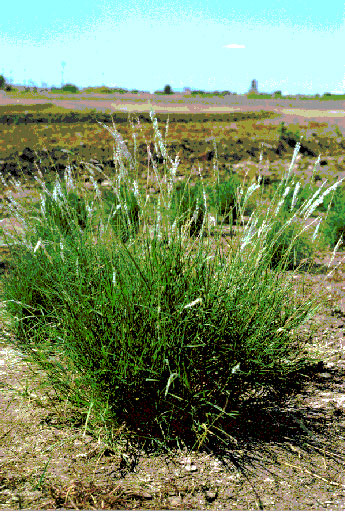‘Loetta’ Arizona cottontop
Digitaria californica
Vegetative Solutions to Conservation Issues
Tucson Plant Materials Center
‘Loetta’ Arizona cottontop
‘Loetta’ Arizona cottontop is a native, perennial bunchgrass that contributes considerable range forage in the Southwest, from southern Colorado to Texas, Arizona, and northern Mexico. This species can be found in the oak woodland, chaparral, and semidesert grassland types in Arizona between 300 and 1,800 m.
Loetta was released in 1999 by the Natural Resources Conservation Service (NRCS) in cooperation with the University of Arizona Agricultural Experiement Station and the Agricultural Research Service of the U.S. Department of Agriculture. It was selected for release because of its overall vigor, seed production, and forage production.
Description
‘Loetta’ Arizona cottontop is described as: Culms firm, erect from a hard base, mostly 45 to 90 cm tall but occasionally much less; Blades flat or somewhat folded, usually glaucous, bluish-green, and glabrous or nearly so, 2 to 5 mm broad; Ligule membranous, 2 mm or more long; Panicle contracted, 10 to 15 cm long, with relatively few branches, these erect, usually appressed; spikelets 3 to 4 mm long excluding the hairs; Second glume narrow, densely villous with soft, silvery hairs 2 to 4 mm or more long; Sterile lemma broad, three-nerved, villous on the margins but glabrous on the internerves; Grain ovate-lanceolate, abruptly narrowing to a short awn-tip, mostly 2.5 to 3.0 mm long.
Adaption
Loetta is adapted to a variety of soils from clay loam to sandy loam as well as loose gravelly soils. Loetta Arizona cottontop is best adapted to Major Land Resource Areas 40-1, 40-2, 40-3, 41-2, and 41-3 in southern Arizona and southwestern New Mexico.
Establishment
In southern Arizona the recommended planting period for rangeland applications using Loetta is from late June through late August coinciding with seasonal summer moisture. The planting rate is 4.0 PLS pounds per acre at a planting depth of ½ inch. It is recommended that Loetta be utilized as part of a seeding mixture comprising approximately 15-30% of the total mix; however, the percent composition may vary depending on the seeding objective. Site characteristics and condition influence the components of a seeding mixture. Compatible species for seedings with Arizona cottontop may include sideoats grama [Bouteloua curtipendula (Michaux) Torrey], cane bluestem [Bothriochloa barbinodis (Lag.) Herter], purple threeawn [Aristida purpurea Nutt.], desert globemallow [Sphaeralcea ambigua Gray], and fourwing saltbush [Atriplex canescens (Pursh) Nutt.].
Seed production of Loetta is restricted to two generations of increase from breeder seed, one each of foundation and certified. Breeder and foundation seed will be maintained by the USDA-NRCS Tucson Plant Materials Center.
At the Tucson Plant Materials Center, ‘Loetta’ Arizona cottontop has been harvested using a Woodward Flail-Vac Seed Stripper using a brush speed of 200 rpm. After drying, the harvested material is then processed through a Westrup Laboratory Brush Huller/Scarifier to remove the hairs from the glumes. The material is then processed through a dual screen air separator using a #8 top screen and a #1/23 bottom screen. It is estimated that ‘Loetta’ produces 614,500 seeds per pound. Seed production has been good to excellent for most years at the Tucson Plant Materials Center.
Environmental Consideration
This release is an indigenous selection collected from within the specie’s natural range of adaptation. This species is documented as having beneficial qualities and no negative impacts on wild or domestic animals. This species has beneficial qualities in terms of diet for wildlife species including pronghorn antelope, mule deer, desert cottontail, whitethroat woodrat, javalina, and scaled quail. The test plots supporting this release were made in close proximity to natural and induced plant ecosystems. There was no evidence of negative impacts or invasion into these ecosystems.
Seed Source:
The Tucson Plant Materials Center will be responsible for maintaining a supply of foundation and breeder seed. Foundation seed will be available for establishing seed source nurseries for commercial production through the Arizona Crop Improvement Association (A.C.I.A.). Standards for all classes of seed will be included in the Arizona Seed Certification Handbook.
